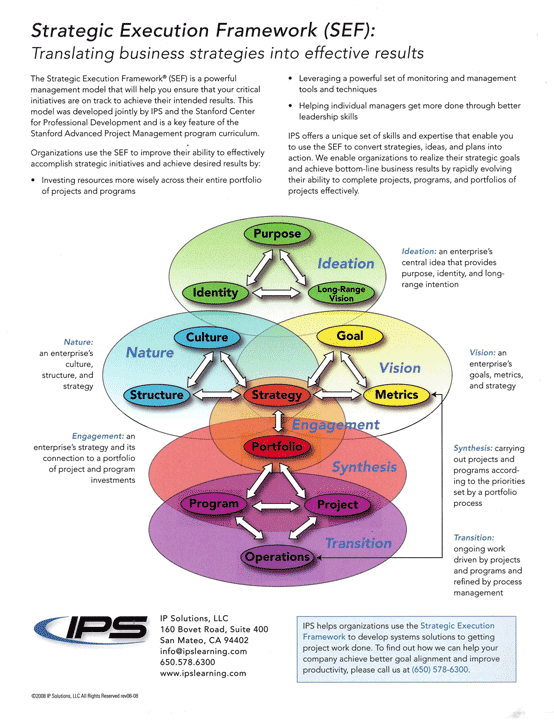You’d think we would be in favor of unplugging. That is, saving energy, preventing waste…you know, being “green”.
And we are in favor of unplugging.
But there’s an exception – a big one.
That exception has to do with a huge source of power for Project Managers, a renewable source of endless project energy that often, as shown in the sophisticated schematic diagram on the right, goes untapped. What is this power of which we speak?
It’s simple – it’s the power of your own organization. And it’s right there ‘above’ and ‘below’ you.
Let’s start at the top. We refer to the power in your organization’s Purpose, Identity, and Long-term Intentions. These are the Top Leadership ideals that are often publicly stated, and always should be communicated to shareholders and employees. They give “ideation” to your organization.
Now let’s jump down to the bottom. Your organization’s heartbeat, its flow, is its operations. This is the day-to-day reality of your business.
And where are we, the project, program, and portfolio managers of the world? We, dear friends, are where the rubber (the strategy that comes from Ideation) meets the road (the operations).
What’s all this coming from?
Below you see the Strategic Execution Framework or SEF (courtesy and copyright of IPS), which is used as the basis of Stanford University’s Center for Professional Development’s Certificate in Advanced Project Management. We were lucky enough to attend one of their courses where this was presented. It struck a chord with us because we have always preached that project managers can gain power by aligning with the organization’s strategy, and often overlook this. Furthermore we have insisted that project managers often put on blinders when it comes to the “end” of their project, failing to connect with (or plug in to) the operations of the company. Why? We’re programmed to consider a project as having a definitive beginning and end – and that end occurs when we hand over the final deliverable.
Only “final” is not so final, after all. When a project, say a bridge, is “done”, that only means that it can BEGIN sending pedestrians and/or vehicles over a river. Does this mean we, as project managers, have to continue monitoring each car as it goes over the bridge? Of course not. But it DOES mean that we should think about the long-term disposition of the bridge in the steady state. It will help us identify risk, connect with stakeholders that we mightn’t have thought of, and in general do a better job of creating sustainable projects. In the bridge example, we assert that the project manager should consider the paving material, not just for its ability to provide improved mileage for vehicles, but also for its ability to withstand heating and cooling without breaking up and requiring repaving every year. At least ask these questions. It will help you connect to the operations ‘below’ and the ‘long term initiatives’ above.
Take a look at the SEF (you forgot already? It stands for Strategic Execution Framework) below. See how important it is for an organization to plug together all of the pieces if they want to get to a sustainable steady-state. And guess who is at the center of it all? You. The well-connected project, program, and/or portfolio manager.
What we expound here are great general PM principles and practices, and by no coincidence, are great green (or better-stated) sustainable PM principles. Even Stanford’s naming of the areas is important. Notice “Long-term Intentions”. Long-term. Smacks of the word “sustainable”, doesn’t it? How about “operations”? Hmm, that word also implies ongoing, enduring…. yes, there it is – sustainability, again.
So why wouldn’t the middle portion of this flowchart (where we PMs live) not ALSO think sustainably? We should! We need to plug in!
- Connect upwards: You don’t have to be a top corporate HQ leader or CEO to know and live the organizations’ strategies.
- Read and re-read your organization’s mission, vision and values. Check messaging from company leaders. Of course we would steer you to messages on sustainability and the environment, but you can derive power for your projects’ charters from any of the messages at the top of the SEF.
- Connect downwards: You can, and should, consider our discipline of PM as distinct from operations. But that doesn’t mean we have to ignore them.
- Get to know the people who will operate the product of your project
- Understand the set of users as a stakeholder group and drink in their requirements and expectations as fodder for risk identification
- Think life-cycle. What happens to the final product of the operations of your product in the long term? Can you learn anything with that mindset? We assert that you absolutely can.
- PLUG IN! Peers in both directions are working towards sustainability, both economic and ecological. We need to pair with these colleagues and learn from both.
Have a look at the SEF, we provide a large version below.
And think, really THINK about whether you are unplugged – and losing a precious source of project power.

So – are you unplugged?
Get connected.
Read our book Green Project Management – it has several chapters on these subjects.
Copyright © 2011 www.Earthpm.com


